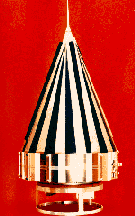Pioneer 3, 4
Part of the Pioneer program
 Following the unsuccessful USAF/NASA Pioneer 0, 1, and 2 lunar missions, the U.S. Army and NASA launched 2 more lunar missions. Smaller than the previous Pioneers, Pioneer 3 and 4 each carried only a single experiment to detect cosmic radiation. Both vehicles were planned to flyby the moon and return data about the Earth and Moon's radiation environment. The launch of Pioneer 3 failed when the launch vehicle first's stage cut-off prematurely. Although Pioneer 3 did not achieve escape velocity, it reached an altitude of 102,332 km and discovered a second radiation belt around Earth. The launch of Pioneer 4 was successful, and Pioneer 4 was the first American spacecraft to escape Earth's gravitational pull as it passed within 58,983 km of the moon (about twice the planned flyby altitude). The spacecraft did return data on the Moon radiation environment, although the desire to be the first man-made vehicle to fly past the moon was lost when the Soviet Union's Luna 1 passed by the Moon several weeks before Pioneer 4.
Following the unsuccessful USAF/NASA Pioneer 0, 1, and 2 lunar missions, the U.S. Army and NASA launched 2 more lunar missions. Smaller than the previous Pioneers, Pioneer 3 and 4 each carried only a single experiment to detect cosmic radiation. Both vehicles were planned to flyby the moon and return data about the Earth and Moon's radiation environment. The launch of Pioneer 3 failed when the launch vehicle first's stage cut-off prematurely. Although Pioneer 3 did not achieve escape velocity, it reached an altitude of 102,332 km and discovered a second radiation belt around Earth. The launch of Pioneer 4 was successful, and Pioneer 4 was the first American spacecraft to escape Earth's gravitational pull as it passed within 58,983 km of the moon (about twice the planned flyby altitude). The spacecraft did return data on the Moon radiation environment, although the desire to be the first man-made vehicle to fly past the moon was lost when the Soviet Union's Luna 1 passed by the Moon several weeks before Pioneer 4.
Spacecraft
Battery powered. Passive thermal control (paint pattern on external surface). Fiberglass external structure.
Payload
2 Geiger counters. Camera trigger mechanism for planned camera system carried as test (no camera).
| Country of Origin | United States |
| Customer/User | US Army, NASA |
| Manufacturer(s) | JPL |
| Size | Conical. 0.51 meter tall, 0.23 m diameter base |
| Orbit | 3: Reached apogee of 102,332 km before reentering Earth's atmosphere / 4: Solar orbit. Passed within 60000 km of Moon |
| Design Life | Several days |
Launch Facts
| Name | Int'l Desig. | Date | Site | Vehicle | Orbit | Mass(kg) |
| Notes | ||||||
| Pioneer 3 | 1958-[Theta]1 | 12/6/58 | ESMC | Juno 2 | HEO | 6 |
| Failed to reach moon; provided radiation data | ||||||
| Pioneer 4 | 1959-[Nu]1 | 3/3/59 | ESMC | Juno 2 | Solar | 6 |
| Passed within 60000 km. of moon | ||||||
Information in The Mission and Spacecraft Library is provided without warranty or guarantee. USE AT YOUR OWN RISK.